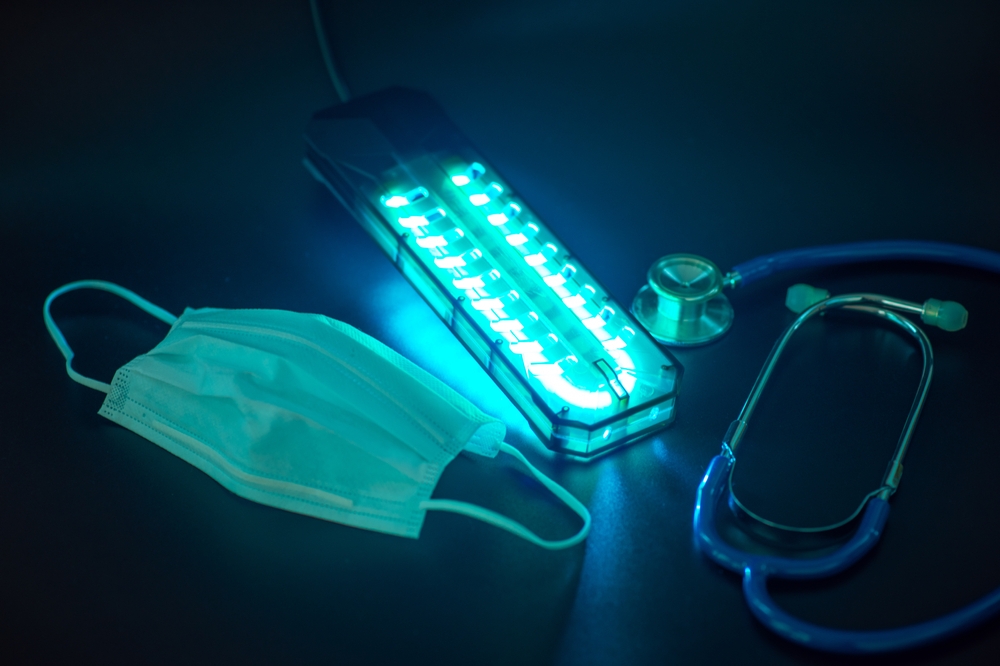Deep UV LEDs: Busting market myths

While the pandemic has propelled interest in the deep UV LED, it is
water treatment that remains the long-term revenue driver for this
device.
BY RICHARD STEVENSON, EDITOR, CS MAGAZINE
How do you apply the brakes to a pandemic? One option for preventing its spread is to introduce measures such as PPE and social distancing; and another is to disarm this virus, through the likes of vaccination, chemical treatment and bombardment by radiation.
It’s the latter line-of-attack that drove intense interest in the UVC LED when Covid dominated the global agenda. But has this left a lasting legacy, as many would have hoped?
Well, probably not, according to executives at AquiSense, a US-based provider of water treatment systems employing LEDs emitting in the deep UV.
The President and CEO of this company, Oliver Lawal, reasons that while many considered using deep-UV LEDs to prevent airborne transmission of Covid, device development could not move fast enough.
Looking back at that time, Lawal says that he struggled to distinguish between marketing noise and real work. “I feel like some of it was just like banging on a drum.”
Due to this, he wonders whether the producers of disinfection systems based on deep-UV LEDs that switched their focus to air disinfection are regretting that decision, given the transient nature of that market.
AquiSense’s CTO, Jennifer Pagán, tends to agree: “If you pivoted into making office air disinfection systems that sit on your desk, you might have seen a really big upswing during Covid, but probably no one's buying them now.”
Throughout the Covid outbreak, AquiSense continued to prioritise water treatment, a strategy that has always delivered revenue growth. “We doubled in the pandemic; but we doubled in the years before the pandemic and we doubled again after it,” says Lawal.
To continue to drive sales, AquiSense is expanding its portfolio, including the launch last month of the PearlAqua Deca 30C. Helping to fill a gap in its range of water purifiers, this particular product, which has attracted plenty of pre-orders, will start being shipped in a matter of days. Lawal expects that the Deca 30C will enjoy most success in the beverage and healthcare industries.
The PearlAqua Deca 30C provides over 99.99 percent pathogen reduction at a flow rates of 15 litres per minute.
Tapping into massive markets
Opportunities to increase the company’s sales are vast, given that millions of homes in North America and Europe are not connected to a municipal water supply.
It’s also worth noting that for some homeowners that are connected, UV treatment still appeals, providing what Lawal describes as a “second barrier”. While a wish for some, it’s a necessity for the immuno-compromised, enabling sales to hospitals and care homes.
Thanks to the tremendous success of AquiSense, it’s a top-three customer for many of the leading suppliers of UVC LEDs. Due to this, the company is in a great position to provide an informed view on the progress of these device makers, and the performance of their products.
Pagán says that following consolidation in the market around 2015, including the acquisition of SETi by Seoul Semiconductor, there has been an uptick in the number of players on the market over the last few years. New entrants include the likes of CrayoNano, Osram and Silanna, all joining the ranks of producers of high-power devices. These suppliers sit above a second tier, which includes a number of Chinese chipmakers, shipping lower-power variants.
The power of the very best devices continues to increase at good pace, with internal measurements at AquiSense indicating a rate of improvement beyond that described by Haitz’s Law (see Figure). Such gains in power are highly valued, enabling water treatment at either a faster flow rate or a higher dose.
AquiSense’s in-house measurements indicate that UV LEDs are improving
at a rate that exceeds the pace of Haitz’s Law. Three types of device
are included: those house in TO cans; surface-mount devices (SMDs); and
chip on substrate (CoS).
Best-in-class devices are now edging 6 percent wall-plug efficiencies, according to Pagán, along with output powers that can be as high as 150 milliwatts. “I think the target for a lot of manufacturers is to be at the 8 percent range within another twelve months or so.”
With greater powers comes the temptation to try and increase the price – but this is a threat to far greater success for all involved, warns Lawal, who argues that many makers of UVC LEDs are underestimating the competitiveness of the incumbent technology, the mercury lamp. Should sacrifices in UVC LED pricing be made, India could move completely away from the mercury lamp within just 5 years, says Lawal.
“The Indian market currently has around 3 million mercury systems a year, and we believe we're on the verge of cracking a chunk of that market. But to do that, I can't go in at a price point that I'm going in in North America.”
Another key characteristic of the UVC LEDs is its lifetime, with different producers quoting different values for the time taken for the intensity to fall by different values – this might be 90 percent, 70 percent or 50 percent.
A lack of standardisation is not a major concern for those at AquiSense, partly because they manage the situation by monitoring the device as it’s used.
There are three levels of sensing: pass/fail; temperature monitoring; and the recording of the intensity of the UV output. “I think we’re unique,” argues Lawal. “We’re definitely the only company that is providing that level of operational sensing.”
Such scrutiny shows that AquiSense is well placed to comment on where developers of UVC LEDs should direct their efforts.
“I want them to focus on epitaxial growth, efficiency and contact efficiency,” says Pagán, who believes that there has been too much emphasis on packaging.
It’s a clear message – and should success follow, it will accelerate humanity’s access to healthy drinking water in a post-Covid era.


































